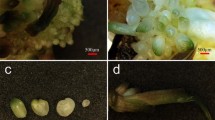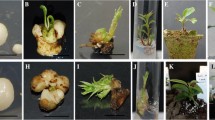Abstract
In Agrobacterium-mediated genetic transformation of cotton (Gossypium hirsutum L. cv. Coker 310FR) the frequency at which somatic embryos were converted to plantlets was significantly improved by subjecting the embryos to slow physical desiccation. We used Agrobacterium strain GV3101 containing the binary vector pGSFR with the nos-nptII gene for in vitro selection and the 35S gus-int fragment as a reporter to optimize the transformation protocol. Although the concentration of kanamycin was reduced during embryogenesis and embryo maturation, even at the lower levels somatic embryos were predominantly abnormal, showing hypertrophy and reduced or fused cotyledons or poor radicle ends. A majority of these embryos (more than 75%) were β-glucuronidase (GUS)-positive. Embryos with an abnormal appearance showed a very poor conversion to plantlets. However, these embryos, when subjected to slow physical desiccation followed by transfer to fresh medium, regenerated single or multiple shoots from the cotyledonary end. These shoots could be grafted on wild-type seedling stocks in vitro, which, following their transfer to soil, developed normally and set seeds. Regenerated plants tested positive for the transgene by Southern analysis. An overall scheme for the high-frequency production of cotton transgenics from both normal and abnormal appearing somatic embryos is presented.




Similar content being viewed by others
Abbreviations
- 2,4-D :
-
2,4-Dichlorophenoxyacetic acid
- BA :
-
Benzylaminopurine
- GA 3 :
-
Gibberellic acid
- GUS :
-
β-Glucuronidase
- NAA :
-
α-Naphthaleneacetic acid
- nptII :
-
Neomycin phosphotransferase II
- WT :
-
Wild type
References
Cousins YL, Lyon BR, Llewellyn DJ (1991) Transformation of an Australian cotton cultivar: Prospects for cotton improvement through genetic engineering. Aust J Plant Physiol 18:481–494
Delbaere R, Reynaerts A, Hofte H, Hernalsteens JP, Leemans J, Van Montagu M (1987) Vectors for cloning in plant cells. Methods in Enzymology 153:277–283
Finer JJ, McMullen MD (1990) Transformation of cotton (Gossypium hirsutum L.) via particle bombardment. Plant Cell Rep 8:586–589
Firoozabady E, DeBoer DL, Merlo DJ, Halk EL, Amerson LN, Rashka KE, Murray EE (1987) Transformation of cotton (Gossypium hirsutum L.) by Agrobacterium- tumefaciens and regeneration of transgenic plants. Plant Mol Biol 10:105–116
Hemphill JK, Maier CGA, Chapman KD (1998) Rapid in-vitro plant regeneration of cotton (Gossypium hirsutum L.). Plant Cell Rep 17:273–278
Jefferson RA, Kavanagh TA, Bevan MW (1987) GUS fusion: β-glucuronidase as a sensitive and versatile gene fusion marker in higher plants. EMBO J 6:3901–3907
Koncz C, Schell J (1986) The promoter of Ti-DNA gene 5 controls the tissue specific expression of chimeric gene carried by a novel type of Agrobacterium binary vector. Mol Gen Genet 204:383–396
Kumar S, Sharma P, Pental D (1998) A genetic approach to in vitro regeneration of non- regenerating cotton (Gossypium hirsutum L.) cultivars. Plant Cell Rep 18:59–63
Luo J, Gould JH (1999) In vitro shoot-tip grafting improves recovery of cotton plants from culture. Plant Cell Tissue Organ Cult 57:211–213
Murashige T, Skoog F (1962) A revised medium for rapid growth and bioassays with tobacco tissue culture. Physiol Plant 15:473–497
Perlak FJ, Deaton RW, Armstrong TA, Fuchs RL, Sims SR, Greenplate JT, Fischhoff DA (1990) Insect resistant cotton plants. Biotechnology 8:939–943
Rajasekaran K, Grula JW, Hudspeth RL, Pofelis S, Anderson DM (1996) Herbicide-resistant Acala and Coker cottons transformed with a native gene encoding mutants forms of acetohydroxyacid synthase. Mol Breed 2:307–319
Rajasekaran K, Hudspeth RL, Cary JW, Anderson DM, Cleveland TE (2000) High frequency stable transformation of cotton (Gossypium hirsutum L) by particle bombardment of embryonic cell suspension cultures. Plant Cell Rep 19:593–545
Sambrook J, Fritsch EF, Maniatis T (1989) Molecular cloning: a laboratory manual, 2nd edn. Cold Spring Harbor Laboratory Press, Cold Spring Harbor
Sunilkumar G, Rathore KS (2001) Transgenic cotton: factors influencing Agrobacterium- mediated transformation and regeneration. Mol Breed 8:37–52
Umbeck P, Johnson G, Barton K, Swain W (1987) Genetically transformed cotton (Gossypium hirsutum L) plants. Biotechnology 5:263–266
Vancannyet G, Schmidt R, O'Connor-Sanchez A, Willmitzer L, Rocha-Sosa M (1990) Construction of an intron-containing marker gene: splicing of the intron in transgenic plants and its use in monitoring early events in Agrobacterium-mediated plant transformation. Mol Gen Genet 220:245–250
Voo KS, Rugh CL, Kamalay JC (1991) Indirect somatic embryogenesis and plant recovery from cotton (Gossypium hirsutum L.). In Vitro Cell Dev Biol 27P:117–124
Zhang BH, Liu F, Liu ZH, Wang HM, Yao CB (2001) Effects of kanamycin on tissue culture and somatic embryogenesis in cotton. Plant Growth Regul 33:137–149
Acknowledgements
This investigation was supported by a research grant from the Department of Biotechnology, India. BC and SK were supported by Research Fellowships from the Council of Scientific and Industrial Research (CSIR). The technical assistance of Amarjeet Kumar Singh is acknowledged.
Author information
Authors and Affiliations
Corresponding author
Additional information
Communicated by R.J. Rose
B. Chaudhary and S. Kumar contributed equally to the investigation reported here.
Rights and permissions
About this article
Cite this article
Chaudhary, B., Kumar, S., Prasad, K.V.S.K. et al. Slow desiccation leads to high-frequency shoot recovery from transformed somatic embryos of cotton (Gossypium hirsutum L. cv. Coker 310 FR). Plant Cell Rep 21, 955–960 (2003). https://doi.org/10.1007/s00299-003-0613-x
Received:
Revised:
Accepted:
Published:
Issue Date:
DOI: https://doi.org/10.1007/s00299-003-0613-x




